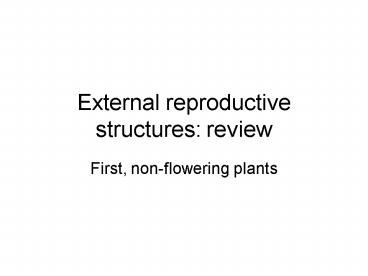External reproductive structures: review PowerPoint PPT Presentation
Title: External reproductive structures: review
1
External reproductive structures review
- First, non-flowering plants
2
Moss sporangia
3
Horsetail (Equisetum) sporangia
4
Fern sori (clusters of sporangia)
5
Knobcone pine cones (serotinous)
6
Burned cone
7
Juniper berry (cone)
8
Cypress (Cupressus) cone
9
Flowers and inflorescences, emphasizing
representatives from prominent California plant
families
10
Collective terms for flower parts
Note this is a perfect flower, i.e., with both
male and female parts
11
Petals
Stigma
Anther
Filament
Style
Sepal
Ovary
Longitudinal section through Petunia flower
12
Simple inflorescence (single flower) Matilija
poppy (Rhomneya coulteri)
13
Largest simple (single) flowerRafflesia
14
Branched inflorescence in the Poaceae (slender
wild oats, Avena fatua)
15
Disc flowers
Ray flowers
Head inflorescence in the Asteraceae (Encelia
farinosa)
16
Stamens (leaflike, many)
Tepals (free, dull-colored)
Primitive flower in the Lauraceae (Umbellularia
californica)
17
Actinomorphic (radially symmetrical) flower in
the Brassicaceae with 4-petals in shape of
cross (Brassica rapa)
18
Zygomorphic (bilaterally symmetrical) flower in
the Orchidaceae (Habenaria sp.)
19
Banner
Wing
Keel
Inflorescence in the Fabaceae--individual flowers
with banner, wing, and keel petals (Lupinus
succulentus)
20
Headlike-inflorescence in the Lamiaceae with
zygomorphic flowers, exserted stamens (Salvia
leucophylla)
21
Monocotyledon flower 6 (2 X 3) tepals, 6
stamens (Hesperoyucca whipplei)
PowerShow.com is a leading presentation sharing website. It has millions of presentations already uploaded and available with 1,000s more being uploaded by its users every day. Whatever your area of interest, here you’ll be able to find and view presentations you’ll love and possibly download. And, best of all, it is completely free and easy to use.
You might even have a presentation you’d like to share with others. If so, just upload it to PowerShow.com. We’ll convert it to an HTML5 slideshow that includes all the media types you’ve already added: audio, video, music, pictures, animations and transition effects. Then you can share it with your target audience as well as PowerShow.com’s millions of monthly visitors. And, again, it’s all free.
About the Developers
PowerShow.com is brought to you by CrystalGraphics, the award-winning developer and market-leading publisher of rich-media enhancement products for presentations. Our product offerings include millions of PowerPoint templates, diagrams, animated 3D characters and more.

